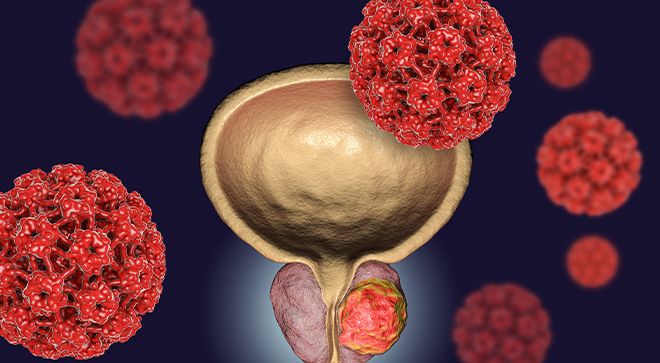News
Article
Find the ‘Goldilocks’ of Prostate Cancer Treatment or Surveillance
Author(s):
There are risks of patients with prostate cancer being over- and under-treated, which is why speaking to a team of doctors is important, an expert said.
Consulting with a team of doctors regarding prostate cancer can ensure a proper plan, whether it's treatment or active surveillance.

For patients who recently received a diagnosis of prostate cancer, discussing the next steps with a provider is important, especially when considering whether treatment or active surveillance is appropriate, an expert told CURE®.
According to the American Cancer Society, active surveillance is when doctors monitor the cancer closely through tests. Specifically, prostate-specific antigen levels are tested every six months from blood draws, and a digital rectal exam occurs once a year. At the same time, the doctor will create a treatment plan if the tests show a rapid change or growth in the cancer.
Dr. Stephanie Berg, medical oncologist at Dana-Farber’s Lank Center of Genitourinary Oncology, spoke with CURE® about how it is decided whether patients undergo active surveillance or receive treatment, the importance of genetic testing and advice for patients with prostate cancer.
CURE®: How is it decided which treatment is best for patients with prostate cancer?
Berg: At Dana-Farber, we have a multidisciplinary team, and we find it extremely important to have different opinions about care. So, being from medical oncology, radiation oncology and surgical oncology, talking about the different pros and cons of each approach and asking, “Is treatment needed at this time for your prostate cancer?” One of the ways that we discuss a form of treatment is actually not really a treatment at all, but something called active surveillance, where we routinely do blood tests, take pictures of the prostate and the organs — like the bladder and the lymph nodes — in the pelvis, and either biopsy and perhaps not treat patients’ prostate cancer right now, but maybe years down the road, or get treatment recommendations soon and start medical therapy.
So we really want to give patients all the pros and cons. If patients don't have that at their center, I would say it's always great to look out for someone like me like a medical oncologist, which there are a lot of us in the United States … to get more of a medical opinion, because we really serve as a liaison amongst the surgeons and radiation oncologists of knowing which modality might be best for you. Since we are trained as medicine doctors, being primary care doctors is kind of our background. In medicine, we are primary care in the beginning. So that's the hat that we like to wear.
LEARN MORE: ‘Paths’ of Treatment Possibilities in Prostate Cancer
How do doctors determine whether patients should receive treatment or undergo active surveillance?
Thankfully, we have some nice guidelines that have been discussed amongst the National Cancer Comprehensive Network and the American Cancer Society, the Association of Surgical Oncology, and the Prostate Cancer Foundation, to name a few, where we're saying, “Which [patient] will benefit from treatment? Or which [patient] can perhaps wait?”
[Regarding] active surveillance, there have been large trials saying that this is an extremely necessary type of treatment option, where serial blood testing, coming to the doctor,— usually the urologist— to just keep track of the cancer [is done].
Knowing the chances of death from this diagnosis of cancer, is really important, because “cancer” is obviously a word that nobody likes to hear. But it is important to discuss with your provider, whether the treatment could perhaps be more harmful to me in the beginning versus close monitoring. This has really changed in the last 10 years in prostate cancer medicine, recognizing the fact that many men were over-treated, perhaps some are under-treated and kind of finding that Goldilocks type of in-between amongst all of us. That’s why multi-[clinician]-deep care with different opinions is really, really important.
What is the role of genetics in prostate cancer?
It’s huge. It's something where family history of any cancer is very important for every man to know, from their dad, brother, uncle and grandfather.
We know that national guidelines are recommended for men with high-risk prostate cancer, we determine different categories of risk based on certain characteristics and your doctor will tell you what [risk level] you are. If you know you have that family history, tell your team, because getting a genetic test where it could have been inherited from your mom or your dad, can result in upwards of 10% or more prostate cancers — we're discovering more every day.
Also, see a genetic counselor. I think that’s the most important part: if you do get a genetic test, somebody has to explain it to you. We value that you see a professional genetic counselor, and get your testing done in a secure format through your medical team. Have someone explain what the results mean. If a physician recommends you get it and tell them your history, that's something I always want to emphasize because that's just important. It's just good medicine to practice that we want to tell our patients.
What advice would you offer to patients with prostate cancer?
If you have prostate cancer, talk to your friends. Tell them that you were diagnosed with it and make sure that they are screened properly — to go see their primary care doctors. A lot of times we see men who have their PSAs or symptoms too late, and they just don't want to talk about it or bring it up.
It’s important to get that first round of care going in because it is the most common cancer that is diagnosed in the United States. And to emphasize, it is nothing to be ashamed of or something you shouldn’t talk about, but just get screened. Talk about it, go see your doctor, and then once it is treatable, we have so many different modalities now to really tailor each treatment to each patient, which is why we talk about the surveillance part, the surgery, the radiation part for localized disease, so we can really get a handle on it early versus later stages.
This transcription was edited for clarity and conciseness.
For more news on cancer updates, research and education, don’t forget to subscribe to CURE®’s newsletters here.




